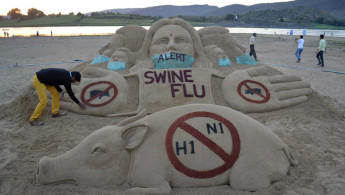Dozens dead in Iran swine flu outbreak
Iran's health minister warned that swine flu was likely to spread to Tehran, after the H1N1 virus killed 28 people in Iran's Kerman province and five in Sistan-Baluchistan.
2 min read
The 2009-10 swine flu pandemic killed at least 18,500 people [AFP]
An outbreak of swine flu has left 33 people dead in two provinces of southwestern Iran in the past three weeks, the official IRNA news agency reported on Monday.
There have been 28 deaths in Kerman province and five in Sistan-Baluchistan, said Deputy Health Minister Ali Akbar Sayyari, who warned the H1N1 virus was likely to spread to other areas, including the capital.
"The health ministry predicts that the virus will spread in the coming days to Tehran, West and East Azerbaijan and Kermanshah provinces more than to other places," he said.
Nearly 600 people have been hospitalised in Kerman province over the outbreak, the head of the province's medical university, Ali Akbar Haghdoost, told the ISNA news agency.
"Traces of the H1N1 virus were uncovered three weeks ago and we were the first province to report the epidemic," Haghdoost said.
He called for limited travel during a three-day holiday weekend due to start on Thursday in order to prevent the spread of the virus.
Haghdoost suggested the outbreak was now under control.
"We have received 5,000 doses of vaccines today and a shipment of 15,000 will arrive tomorrow," he said.
Health Minister Hassan Hashemi said on Sunday the number of deaths was similar to previous years, but that it was evolving and becoming harder to treat.
"This flu comes from beyond our borders, especially from Sistan-Baluchistan" near Pakistan, Hashemi said, quoted by the Youth Journalist Club (YJC) state television website.
"But every year it becomes wilder and more resistant" to treatment, he added.
YJC only referred to the illness as the flu, and made no mention of swine flu.
Patients suffering from diabetes, cardiovascular, kidney, lung diseases and cancer, as well as the elderly, children under five and pregnant women are more sensitive to the virus and must be vaccinated, said Sayyari.
A senior official from the Health Ministry's Infectious Disease Department on Monday reported the state of swine flu to parliament's hygiene and treatment committee, IRNA reported.
A major H1N1 outbreak in 2009 sparked a World Health Organisation pandemic alert in June 2009, after the virus emerged from Mexico and the United States.
The alert was lifted in August 2010 and the outbreak left some 18,500 people dead across 214 countries.
The first instance of swine flu in Iran was reported in June 2009 when a 16-year-old Iranian boy entered the country with his family on a flight from the United Sates.
There have been 28 deaths in Kerman province and five in Sistan-Baluchistan, said Deputy Health Minister Ali Akbar Sayyari, who warned the H1N1 virus was likely to spread to other areas, including the capital.
"The health ministry predicts that the virus will spread in the coming days to Tehran, West and East Azerbaijan and Kermanshah provinces more than to other places," he said.
Nearly 600 people have been hospitalised in Kerman province over the outbreak, the head of the province's medical university, Ali Akbar Haghdoost, told the ISNA news agency.
"Traces of the H1N1 virus were uncovered three weeks ago and we were the first province to report the epidemic," Haghdoost said.
| We have received 5,000 doses of vaccines today and a shipment of 15,000 will arrive tomorrow - Ali Akbar Haghdoost |
He called for limited travel during a three-day holiday weekend due to start on Thursday in order to prevent the spread of the virus.
Haghdoost suggested the outbreak was now under control.
"We have received 5,000 doses of vaccines today and a shipment of 15,000 will arrive tomorrow," he said.
Health Minister Hassan Hashemi said on Sunday the number of deaths was similar to previous years, but that it was evolving and becoming harder to treat.
"This flu comes from beyond our borders, especially from Sistan-Baluchistan" near Pakistan, Hashemi said, quoted by the Youth Journalist Club (YJC) state television website.
"But every year it becomes wilder and more resistant" to treatment, he added.
YJC only referred to the illness as the flu, and made no mention of swine flu.
Patients suffering from diabetes, cardiovascular, kidney, lung diseases and cancer, as well as the elderly, children under five and pregnant women are more sensitive to the virus and must be vaccinated, said Sayyari.
A senior official from the Health Ministry's Infectious Disease Department on Monday reported the state of swine flu to parliament's hygiene and treatment committee, IRNA reported.
A major H1N1 outbreak in 2009 sparked a World Health Organisation pandemic alert in June 2009, after the virus emerged from Mexico and the United States.
The alert was lifted in August 2010 and the outbreak left some 18,500 people dead across 214 countries.
The first instance of swine flu in Iran was reported in June 2009 when a 16-year-old Iranian boy entered the country with his family on a flight from the United Sates.





 Follow the Middle East's top stories in English at The New Arab on Google News
Follow the Middle East's top stories in English at The New Arab on Google News
![Both Hamas and the Palestinian Authority welcomed the ICC arrest warrants [Getty]](/sites/default/files/styles/image_330x185/public/2024-11/GettyImages-2178351173.jpg?h=199d8c1f&itok=TV858iVg)

